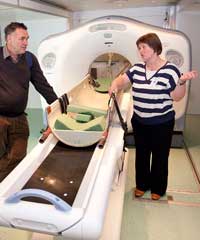Sheep Event 2010: CT scanning can help fine-tune breeding

CT (Computerised Tomography) scanning may appear only relevant to the big boys, but any sheep farmer looking to improve breeding stock can benefit, according to SAC’s Kirsty McLean.
Speaking to Farmers Weekly at NSA Sheep 2010, Malvern, Ms McLean said CT scanning alongside Signet performance recording provided the opportunity for producers to improve EBVs quickly.
“The CT Scanner gives 96-98% accuracy for muscle and fat and enables the formulation of more accurate breeding values. This allows farmers to make informed choices on tup selection.”
By CT scanning, each animal is given predicted values for carcass tissue weights, carcass quality, and percentage muscle in the legs, loin and chest. These figures can then be benchmarked against averages for the breed.
“The farmer will also receive three scan pictures of the eighth rib, fifth lumbar vertebrae and back of pelvis, giving an idea of chest muscle, loin and hindleg.”
SAC has two CT scanners, one static unit in Scotland and another mobile unit which has been based at Nottingham Vet School.
As an addition to Signet recording, stock are CT scanned two weeks before the end date for Signet recording and after the usual ultra sound assessment.
“Usually all lambs will be ultrasounded and then 6-7 of the top lambs from various sires will undergo CT scanning.”
And with the service subsidised by EBLEX, Hybu Cig Cymru (HCC) and SAC, cost does not have to be a barrier to using the service, explains Ms McClean.
The usual price for using the scanner is about £85 a lamb, but with the subsidised service, it costs farmers about £30.
CT scanning is relevant for any producer new to recording or anybody who has introduced new bloodlines and wants to get information quickly, says EBLEX’s Samuel Boon.
“CT is a good way to fast track the process of collecting data and allows certain animals to ‘shine through’.
Result from lamb scanning will also affect all lambs with the same parentage, so it is possible to pull their breed value up as well, explains Ms McLean.
However it is important to be aware that the process will also pick up weaknesses in stock, meaning EBVs could potentially come down as a result, says Mr Boon.
